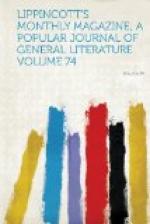One morning, attracted by an unusual noise, I looked out and found it proceeded from a funeral procession. First came a man carrying the lid of the coffin; then several Greek priests; after them boys in white robes with lighted candles, followed by choir-boys in similar dresses who chanted as they walked along. Such sounds! Greek chanting is a horrible nasal caterwauling. Get a dozen boys to hold their noses, and then in a high key imitate the gamut performed by several festive cats as they prowl over the housetops on a quiet night, and you have Greek, Armenian or Turkish chanting and singing to perfection. There is not the first conception of music in the souls of these barbarians. Behind this choir came four men carrying the open coffin. The corpse was that of a middle-aged man dressed in black clothes, with a red fez cap on the head and yellow, red and white flowers scattered over the body. The hot sun shone full on the pinched and shriveled features, and the sight was most revolting. Several mourners followed the coffin, the ladies in black clothes, with black lace veils on their heads and their hair much dressed. The Greeks are obliged to carry their dead in this way, uncovered, because concealed arms were at one time conveyed in coffins to their churches, and then used in an uprising against the government. We witnessed a still more dreadful funeral outside the walls. A party, evidently of poor people, were approaching an unenclosed cemetery, and we waited to see the interment. The body, in its usual clothes, was carried on a board covered by a sheet. When they reached the grave the women shrieked, wept and kissed the face of the dead man: then his clothes were taken off, the body wrapped in the sheet and laid in the grave, which was only two feet deep. The priest broke a bottle of wine over the head, the earth was loosely thrown in, and the party went away. There is no more melancholy spot to me than a Turkish cemetery. The graves are squeezed tightly together, and the headstones, generally in a tumble-down state, are shaped like a coffin standing on end, or like a round hitching-post with a fez cap carved on the top. Weeds and rank wild-flowers cover the ground, and over all sway the dark, stiff cypresses.
A little way down the street is a Turkish pastry-shop. Lecturers and writers have from time to time held forth on the enormities of pie-eating, and given the American people “particular fits” for their addiction to it. Now, while I fully endorse all I ever heard said on the subject, I beg leave to remark that the Americans are not the worst offenders in this way. If you want to see pastry, come to Constantinople: seeing will satisfy you—you won’t risk a taste. Mutton is largely eaten, and the mutton fat is used with flour to make the crust, which is so rich that the grease fairly oozes out and “smells to Heaven.” Meat-pies are in great demand. The crust is baked alone in a round flat piece, and laid out on a counter, which




